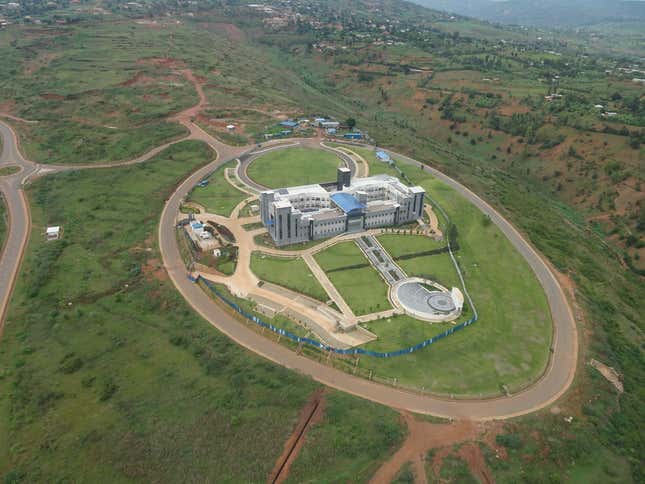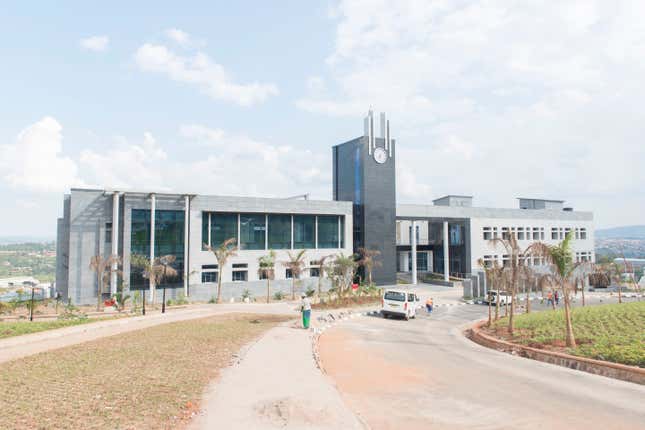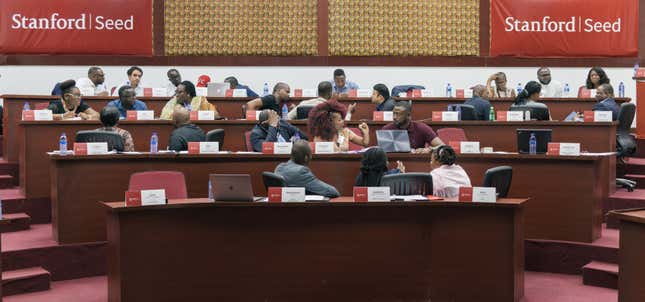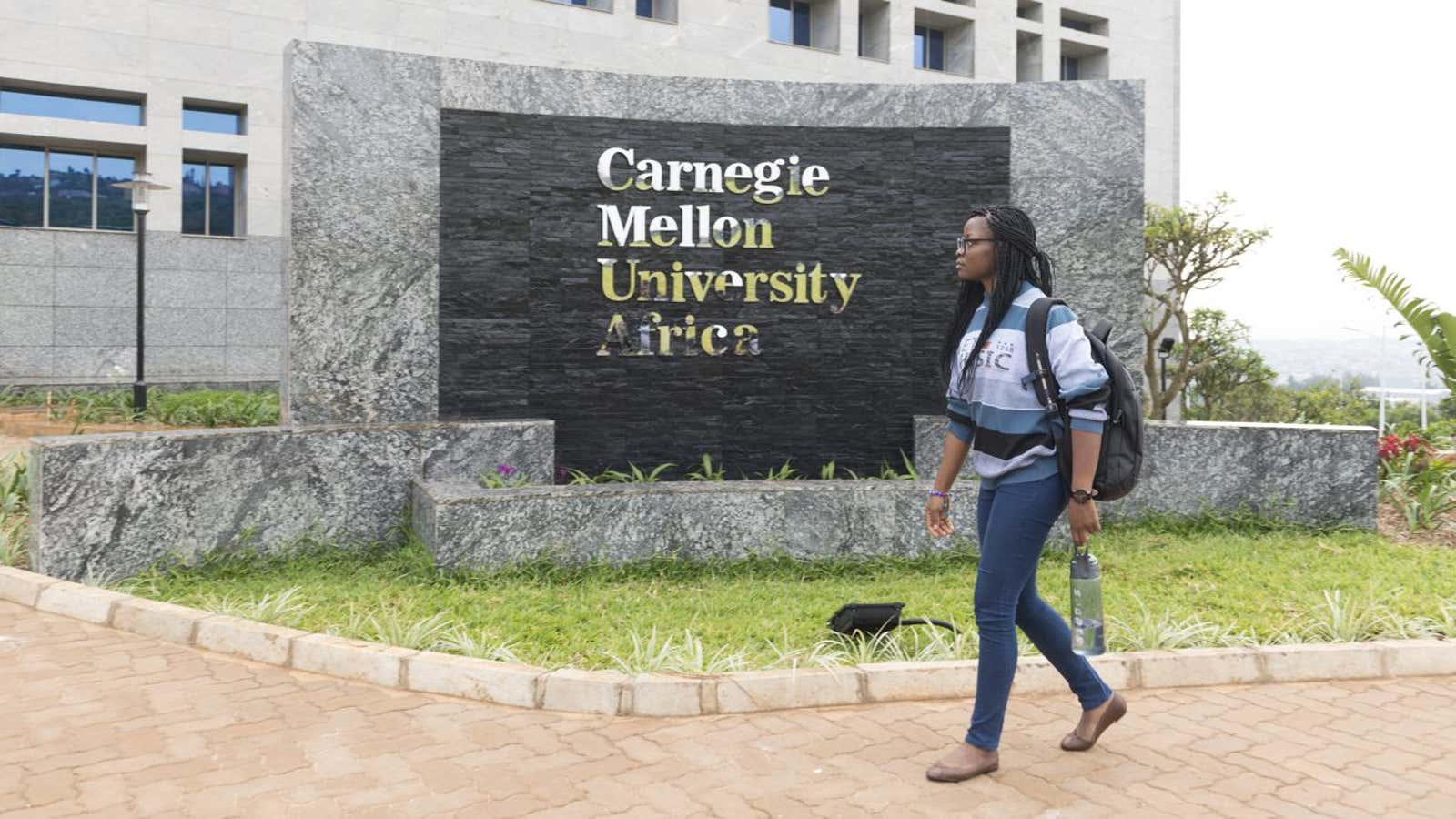Amid the rolling hills on the outskirts of Rwanda’s capital Kigali, the Carnegie Mellon University Africa’s new campus is a prominent feature on the lush landscape.
The 6,000 square meters property is located within the Kigali Innovation City, a public-private partnership aimed at positioning Rwanda as a globally competitive and knowledge-based economy. Since it’s establishment in 2011, CMU Africa has grown from a small graduate program attracting local applicants to becoming the only American research university with a full-time faculty and operations in Africa. Headquartered in Pittsburgh, Pennsylvania, the private university created an outpost in Rwanda with the aim of training high-quality engineers and producing Africa’s next tech leaders.
The new $12-million campus doubles down on that vision, seeking to introduce locally-tailored but globally-competitive packages to solve distinct challenges. But it’s also indicative of the growing presence of American universities in the continent: whether it’s by establishing satellite branches, research centers, or specialized offshoot programs. These universities are deepening their reach in the continent as more global companies set shop and seek top talent for hire.
The move also dovetails with calls from African nations to champion new skills in knowledge as an engine for economic growth, even as higher education continues to face qualitative, quantitative, and funding challenges. With a rapidly-growing, working-age population, governments are also gradually looking to strong educational institutions as a precious resource to create jobs, drive growth, and propel entrepreneurs and scientists onto the world stage.
African universities lag their global rivals when it comes to generating research, with limited funding hindering the ability of academics. The continent’s best universities are also led by research institutions mostly in South Africa including the University of Cape Town and the University of Witwatersrand.
In this context, what American universities are able to offer is the ability to not only provide much-needed funding but also provide space and capacity to do high-end examination on issues ranging from big data and cybersecurity to artificial intelligence.
“We know what a good university and a good educational institution can do to local economies,” CMU Africa director Vijayakumar Bhagavatula says, alluding to the estimated $2.7 billion in annual economic impact the university creates in the Pittsburgh area.
With 196 students graduating from their African campus so far, Bhagavatula adds, “Our vision is to be here, educate African students in Africa, for African applications.”


Some programs are also expanding while apprised of the potential for business to solve Africa’s biggest challenges. Since its launch in Ghana in 2013, Stanford’s Seed initiative has grown from a six-month course to a year-long syllabus that trains not just chief executives and founders but also their teams in eastern and southern Africa. In 2016, Harvard also introduced an executive program targeting business leaders in Africa.
Stanford’s program takes on local companies already earning between $150,000 and $15 million annually and helps them figure out how to grow and scale. The training for business owners—628 of them so far—involves modules in product innovation, management, accounting, and developing winning strategies.
Establishing the program in Africa was part of a strategy to help entrepreneurs who wanted to build businesses that have an impact beyond just quarterly revenues and profits, says the executive director of Seed, Darius F. Teter.
“The business school, in general, understands that the next wave of innovation should and will come from outside Silicon Valley and that Stanford should be a part of that.”
Tumultuous times
Education has long been one of America’s key exports to Africa. US missionaries, for instance, established now-thriving colleges including the American University in Cairo besides Daystar and Strathmore campuses in Kenya. The American government also funded scholarships to train African professionals that would run efficient civil service following independence. This included the famous airlift that took Barack Obama’s father to study in Hawaii and later Harvard.
Globally, American universities like Carnegie and New York University have also established degree-granting and research branches in locations including Qatar, the United Arab Emirates, and Hong Kong.
Yet the latest expansion comes at a time when foreign students aiming to study in the US find themselves squarely in Trump’s crosshairs. The current administration has announced plans to crack down on international students and visitors who overstay in the US, even as the issuance of F-1 student visas continues to drop. Besides banning citizens from some African states, Trump has also imposed visa restrictions and heightened the deportation of people from other African countries.
And as his administration bars some Chinese scholars from visiting the US, Beijing has increasingly built cultural centers. China has now overtaken the US and is training more students from Africa both at home and in China.
These isolationist policies are incongruous to the vision of the Columbia Global Centers (CGC) to further a more integrated world. With eight offices across the world—one in Nairobi, the other in Tunis—the centers were established a decade ago to better understand the realities of a rapidly changing world and how to respond to them.
But where globalization and integration once reigned supreme, rising populism, nationalism, shrinking public spaces, fake news, and extremist speech have risen in their place. Fully comprehending what he in 2016 labeled “societal earthquakes” has only strengthened the value of the centers today, says Columbia University president Lee C. Bollinger. CGC is mulling over setting up an additional center in South Africa.
“We have to be acting in the world as well as thinking about it,” he said during a recent visit to Nairobi. “And to do that, you need to build the institutional capacity to work with outside partners on real problems.”

Challenging ecosystem
In trying to broaden their impact, administrators say they have had to navigate local challenges. CMU Africa, for instance, struggles with bringing in high-end computers to teach courses on robotics.
Business students with Stanford also have to contend with the regulatory regimes in their own countries: whether it’s the forex crisis in Ethiopia or the currency devaluation in Nigeria. But Teter says they are building case studies so that students in Stanford learn from how the Seed participants grow their businesses in these testing environments.
Universities also say they want to scale, increase financial aid, attract more female applicants, and engage more researchers and institutions. “I wish other universities come here,” Bhagavatula says, adding that there’s a need for more high-quality training institutions to set shop in Africa. “I don’t see them as competition. This continent is big.”
Sign up to the Quartz Africa Weekly Brief here for news and analysis on African business, tech and innovation in your inbox
